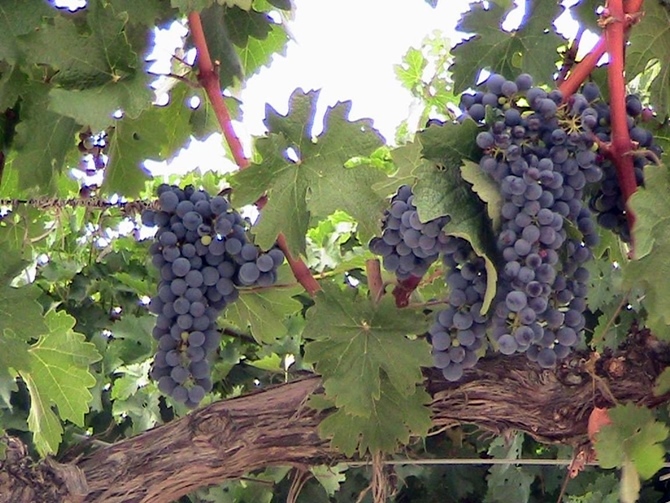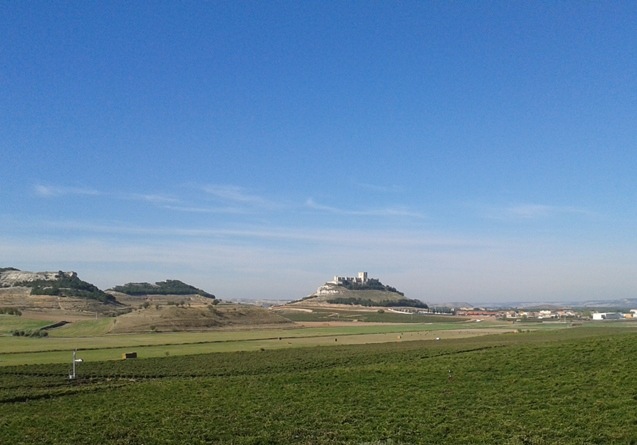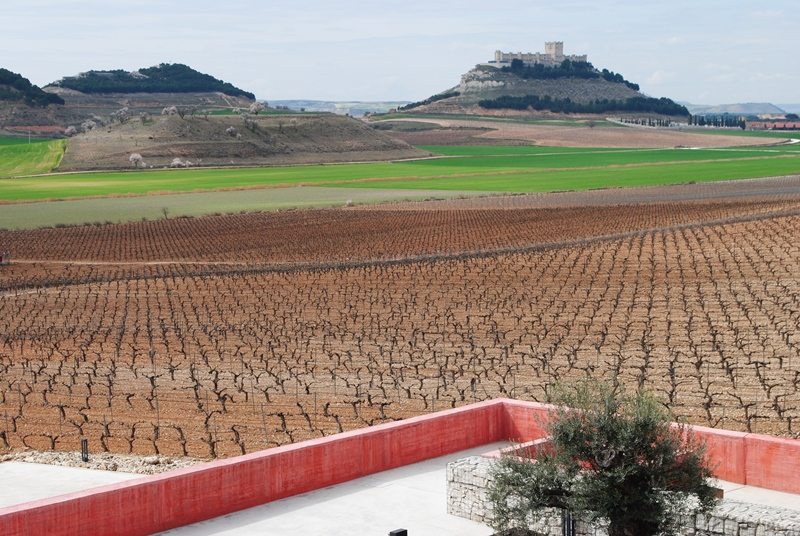We all know that we owe a lot to the Romans- the feats of engineering, the inventions, the creation of basic law, the art. But in the case of Ribera del Duero, we owe them the discovery of the perfect place to grow the tempranillo grape, and the beginnings of the Ribera del Duero wine region.
Do you like full-bodied red wines, exploring ancient ruins and travelling through stunning landscapes? Then Ribera del Duero could be your next destination. To give you a head start, here are some useful tips from inside the wine industry, including where the region is, why it is famous, my favourite winery and how to get there from Madrid.
The scoop
Ribera del Duero is talked about as being one of the most prestigious wine regions in Spain. It is renowned for its full-bodied, elegant and complex red wines, which are of an extremely high quality (the region’s regulatory body only allows a certain amount of grapes to be produced per harvest- meaning that quality is in, and quantity is out).
In fact, in 2012 Ribera won a Wine Star award for being the best wine region in the entire world (which in the wine world is the equivalent to winning the Oscars).
Roman Gods and Medieval fortresses
Ribera del Duero became an official D.O. (Designation of Origin) region in 1982, but wine has been produced here for over 2,000 years. We know for sure that the Roman people of Ribera del Duero made wine, because they left behind mosaics of the Roman God of wine, Bacchus.
Bacchus was, amongst other things, the youthful, beautiful and (somewhat) androgynous God of harvest, wine and general all-round debauchery (he was actually the half mortal son of Zeus, so who can blame him). You can still see a 66 metre mosaic tile floor dedicated to him and his frivolous escapades at the Baños de Valdearados, a small pueblo right in the centre of Ribera del Duero.

The Ancient Romans believed that wine was a ´daily necessity´ and produced wine in Ribera del Duero for everyone in society- men, women, slaves, aristocrats and peasants
In fact, Ribera del Duero gets its entire name from the Romans and their love of wine; they were also so thankful for the blessing of the river on their vineyards, that they personified the river as Durius, a River God (who, we can only assume, was working in cahoots with Bacchus).
Ribera del Duero continued to make wine long after the Romans left- all throughout the Visigoth, Muslim, Christian and medieval eras, right up until today. This means that Ribera del Duero not only has beautiful vineyard landscapes shaped by thousands of years of wine making, but also a winemaking tradition as old as the Coliseum.
If you are interested in medieval history or have a penchant for fairy-tale architecture, Ribera del Duero also has an incredible collection of Middle Age castles. On my last trip, I visited the official ´National Monument´ of the castle of Peñafiel, which is located where all good castles are- on top of a hill.

The castle of Peñafiel
Geography
Ribera del Duero is a long and narrow wine region shaped to follow the path of the Duero river. Ribera del Duero is effectively an extended area of vineyard river bank, which is why the word ´Ribera´ (river bank) is used in its name.
 The Ribera del Duero the wine region includes parts of four regional territories– covering the south of Burgos, extending west into Valladolid and encompassing sections of Segovia in the south and Soria to the east.
The Ribera del Duero the wine region includes parts of four regional territories– covering the south of Burgos, extending west into Valladolid and encompassing sections of Segovia in the south and Soria to the east.
There are 4 main municipalities: Peñafiel, Roa, Aranda del Duero and San Esteban de Gormaz. These are surrounded by rural areas of vineyards and wineries, churches, castles and beautiful valleys.
My favourite winery
There are almost 300 wineries spread over the river banks of Ribera del Duero, a combination of hundred-year-old traditional family wineries and modern corporate giants, but for me, the winery Pago de Carraovejas is a real diamond- a shining example of how to keep Ribera del Duero´s wine traditions alive, but not be afraid of modern innovation.
Back in the 1970´s, a curious young sommelier José María Ruíz had a dream that he would one day own his own restaurant, where he would serve Segovia´s most traditional dish, ´cochinillo´ (roast baby piglet), which would be paired with his own Ribera wine.
Years later, and just 3km outside Peñafiel, Ruíz´s impressive winery is in the perfect location in a sunny valley, protected by the hills from the North Wind and close enough to the river.

The vineyards of Pago de Carraovejas in its special valley this summer 2014, with views of Peñafiel castle in the distance
On my last trip to Ribera, I took part in the unveiling of Pago de Carraovejas´ new wine tasting technique: the peeling and tasting of the skin, pulp and seeds of the grape before tasting the wines. This is a prime example of Carraovejas´ innovative approach to wine and ability to think outside of the box, as is their research with Universities to create their own natural yeasts and bacteria specific to the land.

Pago de Carraovejas in winter, photograph taken by my colleague and wine expert Raul Buendía. As the seasons change, so do the landscapes- with so many vineyards, each season brings unique stunning views
If you tour their winery, not only will you taste their fantastic red wines throughout the tour in different winemaking rooms (a refreshing take on the traditional end-of-tour wine tasting), but you will also get to enjoy 3 delicious tapas dishes (including ´cochinillo´) that have been carefully elaborated in Ruiz´s dream restaurant to pair with the wines.

One of the delicious tapas served in the barrel room on my last visit- a tuna, sautéed pepper and vegetable stack, with edible flower
If you have a food allergy, Pago de Carraovejas are up to the job. They can adapt their tasting menu to gluten free and lactose free diets if you let them know in advance- and they will even serve gluten free bread. You might also want to let them know if you don´t want to eat ´cochinillo´ (baby piglet fed only milk and slaughtered at 15-20 days old), if you are a vegetarian, vegan or have certain meat eating beliefs.
Which wineries?
To see a list of all of the wineries registered in the region, go to the official Ribera del Duero D.O. website.
If this seems too overwhelming and you aren´t sure which winery to pick, or how to organise numerous visits that fit together, you could organise a wine tour of Ribera del Duero from Madrid. You could even visit a winery that produces one of your favourite wines!
How to get there
Ribera del Duero has so many places to visit that you could leave Madrid in a number of different directions, depending on where you are headed. Here are two routes to the wine towns Peñafiel and Aranda de Duero.
By car:
I would recommend travelling to Ribera del Duero by car so that you can see Ribera´s landscapes as you travel up from Madrid. This is all part of seeing Ribera- the land, the vineyards, castles and landscapes have all been shaped by wine making. You will also have the freedom to move about the region once you are there- you could stay in a wine town and drive to rural wineries and castles during the day, returning to eat delicious local food in the town at night.
You can see which companies rent cars in Madrid by going to our previous Travelling by car in Madrid: renting cars, car sharing or carpooling article.
Route: Madrid- Peñafiel
Duration: 2 hours approx.
Tip: Combine this route with a stop at the beautiful UNESCO city of Segovia on the way
Route: Madrid- Aranda de Duero
Duration: 1 hour 45 approx.
Tip: You can find recommended Aranda de Duero scenic driving routes for once you have arrived in the area, on the official Aranda y Ribera guide website. Useful for a weekend trip.
By bus:
It is possible to travel to a few of the wine towns by coach from Madrid. This would be a good option if you would just like to visit the main wine towns.
Route: Madrid- Peñafiel
Depart from: Moncloa
Duration: 3 hours approx.
Price: 17,00 approx. single
Company: The official Peñafiel website cites travelling with La Sepulvedana
Route: Madrid- Aranda de Duero
Depart from: Avenida de America
Duration: 2 hours
Price: 12,00€ approx. single (24,00€ approx. return)
Company: Alsa
Wine word for your trip
El sarmiento– the little young, green vine shoot









































